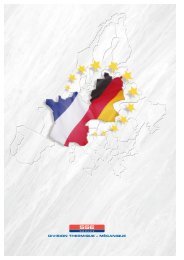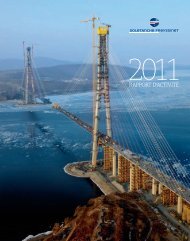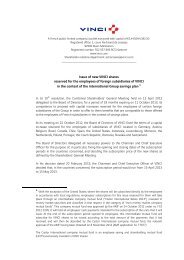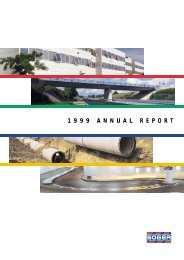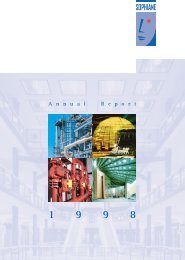VINCI - 2005 annual report
VINCI - 2005 annual report
VINCI - 2005 annual report
You also want an ePaper? Increase the reach of your titles
YUMPU automatically turns print PDFs into web optimized ePapers that Google loves.
4.2. INTERNAL CONTROL WITH RESPECT TO FINANCIAL AND ACCOUNTING<br />
INFORMATION<br />
The Budgets and Consolidation Department, part of the Finance Department,<br />
is responsible for the production and analysis of the fi nancial<br />
information distributed inside and outside the Group, which it must<br />
ensure is reliable. In particular, the Department is in charge of:<br />
– preparing, agreeing and analysing <strong>VINCI</strong>’s half-year and <strong>annual</strong> individual<br />
company and consolidated fi nancial statements and forecasts<br />
(consolidation of budgets, budget updates and three year forecasts),<br />
applying the same procedures as for the preparation of the consolidated<br />
fi nancial statements;<br />
– the defi nition and monitoring of Group accounting procedures and the<br />
transition to IFRS as from 1 January <strong>2005</strong>;<br />
– co-ordination of the “Vision” Group fi nancial information system,<br />
which incorporates the consolidation process and which is used to<br />
unify the various <strong>VINCI</strong> <strong>report</strong>ing systems (accounting and fi nancial<br />
information, human resources information, commercial data, borrowing).<br />
The budget procedure is common to all business lines and their subsidiaries.<br />
It is built around fi ve key dates in the year: the budget for the next<br />
year in November followed by four updates in March, May, September<br />
and November. For each of these stages, management committees meet to<br />
examine each business line’s position and fi nancial data, in the presence<br />
of the Group’s Chief Executive Offi cer and its Chief Financial Offi cer.<br />
A monthly <strong>report</strong> on business, new orders taken, the Group’s order book<br />
and consolidated net borrowing position is prepared by the Finance<br />
Department on the basis of detailed information provided by the business<br />
lines, and is distributed to the General Management.<br />
The Management of each business line prepares a specifi c <strong>report</strong> on the<br />
month’s key events.<br />
The Budgets and Consolidation Department lays down a timetable and<br />
closure instructions for the preparation of the half-year and <strong>annual</strong><br />
accounts. These instructions, sent to the business line Finance Departments,<br />
are presented in detail to the staff in charge of consolidation in<br />
the entities in question.<br />
172<br />
<strong>VINCI</strong> <strong>2005</strong> ANNUAL REPORT<br />
The line items entered in the consolidation pack by divisions through the<br />
“Vision” system are defi ned beforehand by the Budgets and Consolidation<br />
Department. The Group’s accounting rules and methods are also laid<br />
down in the form of widely distributed procedures. Specifi c monitoring<br />
is carried out for some areas, e.g. provisions, deferred tax and off-balance<br />
sheet commitments.<br />
At each accounts closure, business lines send the Budgets and Consolidation<br />
Department a dossier with analysis and comments on the consolidated<br />
data submitted.<br />
The Group Finance Department presents the accounting treatment it<br />
intends using for any complex transactions to the Statutory Auditors in<br />
order to receive their prior opinion.<br />
The Statutory Auditors present their observations on the half-year and<br />
<strong>annual</strong> accounts to the Audit Committee before they are presented to the<br />
Board of Directors and after they have been presented to the Management<br />
of the business lines in question and the <strong>VINCI</strong> holding company.<br />
Before signing their <strong>report</strong>s, the Statutory Auditors request letters of<br />
representation from Group Management and business line management.<br />
In these representations, Group Management and business line managements<br />
confi rm that they consider that the effects of any still unresolved<br />
anomalies noted by the Statutory Auditors, either individually or in<br />
aggregate, do not have a material impact on the fi nancial statements taken<br />
as a whole.<br />
Business lines have management accounting systems tailored to their<br />
own business. Specifi c budgetary control tools have been installed in the<br />
Construction, Roads and Energy business lines and each of the concession<br />
activities (motorways, car parks and airports) and allow regular monitoring<br />
of the progress of sites and contracts.<br />
5. ACTIONS UNDERTAKEN TO STRENGTHEN INTERNAL<br />
CONTROL<br />
5.1. WORK CARRIED OUT BEFORE <strong>2005</strong><br />
In 2003, <strong>VINCI</strong> initiated an action plan intended to enhance the quality<br />
of the internal control system, without bringing into question its features<br />
adapted to the management organisation in force in the Group, which<br />
combines an entrepreneurial culture, the autonomy of operational staff,<br />
transparency and loyalty, and network-based operations.<br />
The project comprised several stages, of which the fi rst, completed in<br />
2003, was to identify the main risks and the associated controls for the<br />
main Group entities and processes.<br />
The second stage related to determining and describing the current<br />
organisation of internal control, the aim being to describe the internal<br />
control arrangements put in place by the various divisions. Self-assessment<br />
questionnaires on the internal control environment, approved by<br />
the Executive Committee, were sent in 2003 and 2004 to managers of<br />
a sample of entities, selected from the largest and most representative<br />
entities. Their replies were analysed and a list was drawn up of the main<br />
procedures in existence.




